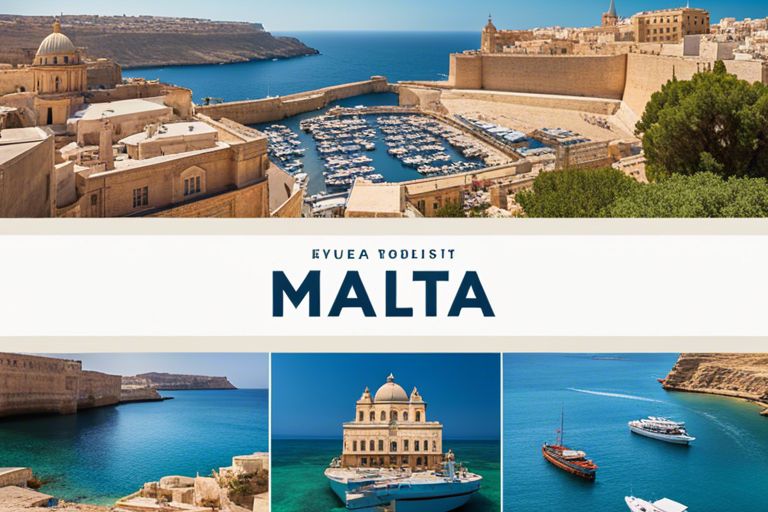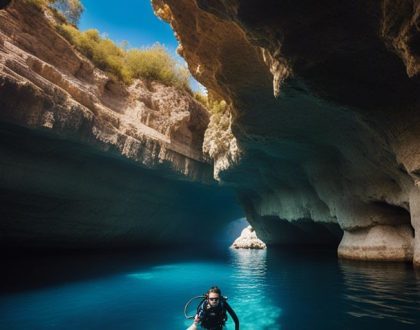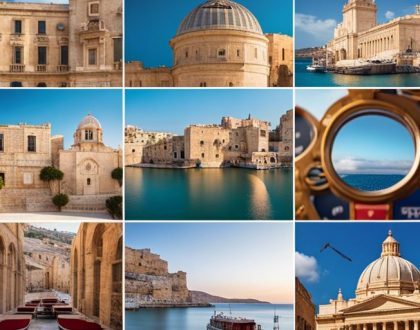The Tourist’s Handbook to Malta

Just off the coast of Sicily lies the small yet captivating island nation of Malta. With its rich history, stunning architecture, and crystal-clear waters, Malta has become a popular destination for tourists from around the world. In this comprehensive handbook, we will explore important tips, hidden gems, and must-see attractions to ensure your visit to Malta is as smooth and enjoyable as possible.
Getting to Know Malta
Geographical Insight
To truly understand Malta, it is crucial to grasp its unique geographical features. Nestled in the heart of the Mediterranean Sea, Malta is a small archipelago comprised of three main islands: Malta, Gozo, and Comino. The islands are known for their stunning coastline, crystal-clear waters, and picturesque landscapes. Despite its small size, Malta boasts a rich diversity of natural beauty, from hidden coves and sandy beaches to rugged cliffs and rolling hills.
Historical Overview
The history of Malta is as fascinating as it is complex. With a history dating back over 7,000 years, the islands have been ruled by various civilizations, including the Phoenicians, Romans, Moors, Knights of St. John, and the British. This diverse heritage is reflected in Malta‘s architecture, cuisine, and traditions, making it a melting pot of cultures and influences.
Any visit to Malta would be incomplete without exploring its rich historical past. The UNESCO World Heritage site of Valletta, the ancient temples of Ħaġar Qim and Mnajdra, and the medieval city of Mdina are just a few of the many historical sites that offer a glimpse into Malta‘s storied past.
Cultural Highlights
For instance, the Maltese people are renowned for their warm hospitality and vibrant traditions. Festivals, such as the annual feast of St. Paul’s Shipwreck and Carnival, showcase the island’s lively spirit and strong sense of community. Additionally, Malta is home to a thriving arts scene, with galleries, theaters, and music venues that celebrate both traditional and contemporary Maltese culture.
Any exploration of Malta‘s cultural scene would not be complete without sampling the local cuisine. Maltese food is a delicious blend of Mediterranean flavors, with dishes like rabbit stew, pastizzi, and ftira bread being popular among locals and visitors alike.
Preparing for Your Trip
One of the first steps in planning your trip to Malta is to prepare adequately. This chapter will guide you on the vital aspects to consider before begining on your journey, ensuring a smooth and enjoyable experience.
Best Times to Visit
Any time of year is a good time to visit Malta, as the weather is generally pleasant year-round. However, the best times to visit are during the shoulder seasons of spring (April to June) and autumn (September to November). During these periods, the weather is mild, and the tourist crowds are thinner, allowing you to explore the islands comfortably. Summer (July to August) is peak tourist season, with the highest temperatures and larger crowds at popular attractions.
What to Pack
With its Mediterranean climate, Malta experiences hot summers and mild winters, making it vital to pack appropriately for your trip. In summer, pack lightweight and breathable clothing, sunscreen, a hat, and sunglasses to protect yourself from the sun. Don’t forget to pack comfortable walking shoes for exploring the island’s historic sites and rugged terrain.
What to Pack: Consider packing a reusable water bottle to stay hydrated and reduce plastic waste, as well as a power adapter to charge your electronic devices in Malta’s Type G electrical outlets.
Understanding Maltese Etiquette
Best known for their warm hospitality, the Maltese people appreciate visitors who show respect for their customs and traditions. When interacting with locals, remember to greet them with a friendly “bonġu” (good morning) or “il-ħin it-tajjeb” (good afternoon). It is also customary to offer a small gift or token of appreciation when invited to a Maltese home for a meal.
Understanding Maltese Etiquette: Taking off your shoes before entering someone’s home is a sign of respect in Maltese culture and is expected when visiting a private residence.
Transportation in Malta
Navigating the Airport
All visitors arriving in Malta will be welcomed at the Malta International Airport, located near the town of Luqa. International flights connect Malta to major European cities, making it a convenient entry point for tourists. After disinitiateing, travelers can easily find their way through the well-signed airport to baggage claim and immigration. Taxis, rental cars, and public transport options are available just outside the terminal, offering convenient ways to reach your accommodation.
Public Transport Options
Any tourist looking to explore Malta on a budget should consider using the efficient public transport system. Buses run regularly between major towns and tourist attractions, with routes covering the entire island. The bus network is a cost-effective and eco-friendly way to travel around Malta, especially for those staying in urban areas. For added convenience, consider purchasing a Tallinja card, which offers discounted fares and can be easily topped up at various outlets across the island.
An extensive network of bus routes makes it easy for visitors to reach popular destinations such as Mdina, the Blue Grotto, and St. Julian’s. Buses are equipped with air conditioning, making the journey comfortable even in the hotter months. Keep in mind that bus schedules may vary on weekends and public holidays, so it’s advisable to plan your trips accordingly.
Renting Vehicles and Local Driving Laws
With Malta’s small size and well-maintained road network, renting a car can offer the flexibility to explore the island at your own pace. Several international car rental companies operate in Malta, providing a wide range of vehicle options to suit your needs. Having a rental car allows you to visit hidden gems off the beaten path and make spontaneous stops along the picturesque coastline. Remember to drive on the left side of the road in Malta, and always adhere to speed limits and parking regulations to ensure a safe journey.
With a valid driver’s license from your home country, you can easily rent a vehicle in Malta as long as you meet the minimum age requirement, usually 21 years old. Insurance is typically included in the rental agreement, but it’s advisable to check the coverage details with the rental company. Take note of the local traffic signs and be cautious when driving in busy urban areas or narrow streets in villages.
Accommodations and Dining
Now, as a tourist visiting Malta, it is crucial to ensure your accommodations and dining experiences are of the highest quality to fully enjoy your stay on the island. Here is an overview of what to consider when choosing where to stay and where to dine in Malta.
Choosing Where to Stay
Where you choose to stay in Malta can greatly impact your overall experience. Whether you prefer a luxurious beachfront resort, a cozy boutique hotel in the heart of Valletta, or a quaint guesthouse in the countryside, Malta offers a wide range of accommodation options to suit every traveler’s preferences and budget. Popular areas to stay in Malta include St. Julian’s, Sliema, Valletta, and Mdina, each offering unique charms and attractions.
Maltese Cuisine and Dining Experiences
With a blend of Mediterranean, Sicilian, North African, and British influences, Maltese cuisine is a delightful fusion of flavors and traditions. When dining in Malta, you can expect to savor fresh seafood dishes, hearty stews, flavorful pastries, and delicious wines. Be sure to try traditional dishes such as rabbit stew (fenkata), pastizzi (flaky pastries filled with ricotta or peas), and ftira (a local bread similar to pizza). For a truly authentic dining experience, visit local eateries known as ‘pastizzerias’ or ‘qassatat shops’.
Vacation Tip: While exploring Maltese cuisine, be aware that some traditional dishes may contain allergens like nuts or gluten, so it’s important to communicate any dietary restrictions to your server when dining out. Additionally, reservations are recommended for popular restaurants, especially during peak tourist seasons, to avoid long wait times. Embrace the culinary delights of Malta and immerse yourself in the rich flavors of this beautiful Mediterranean island.
Sightseeing and Attractions
Must-See Historical Sites
Your visit to Malta would not be complete without exploring the must-see historical sites that dot the islands. Valletta, the capital city, is a UNESCO World Heritage Site and home to numerous architectural gems, including St. John’s Co-Cathedral, a stunning example of baroque architecture. The ancient citadel of Mdina offers a glimpse into Malta’s medieval past, while the megalithic temples of Ħaġar Qim and Mnajdra date back to 3600-2500 BC, making them some of the oldest free-standing structures in the world.
Natural Wonders of Malta
An exploration of Malta’s natural wonders is a must for nature enthusiasts. The Blue Grotto, a series of picturesque sea caves on the southern coast of Malta, offers stunning azure waters and breathtaking views. The Ġgantija Temples in Gozo, another UNESCO World Heritage Site, are older than the Egyptian pyramids and provide insight into Malta’s ancient past and mysterious folklore.
Sightseeing: Make sure to bring your camera to capture the breathtaking landscapes and unique geological formations that make up Malta’s natural wonders.
Museums and Art Galleries
Plus, enrich your understanding of Malta’s history and culture by visiting its museums and art galleries. The National Museum of Archaeology in Valletta showcases artifacts from Malta’s prehistoric periods, while MUŻA, the national art museum, features a diverse collection of works from local and international artists. Don’t miss the opportunity to visit St. John’s Co-Cathedral, home to Caravaggio’s famous painting, “The Beheading of Saint John the Baptist.”
Natural: Dive deeper into Malta’s artistic and historical heritage by exploring its museums and art galleries, which offer a rich tapestry of exhibits and collections.
Religious Sites and Festivals
Another highlight of Malta’s cultural landscape is its religious sites and festivals. The Mosta Dome, a massive church with a famous rotating dome, and the charming fishing village of Marsaxlokk, known for its vibrant fish market and religious processions, are popular destinations. Immerse yourself in the local culture by attending one of Malta’s many festivals, such as the Feast of St. Paul’s Shipwreck in Valletta, which features parades, fireworks, and traditional Maltese delicacies.
To: Experience the rich traditions and spiritual heritage of Malta by visiting its religious sites and participating in its colorful festivals, where you can witness local customs and festivities up close.
Activities and Experiences
Outdoor Adventures
For travelers seeking an adrenaline rush in Malta, look no further than the numerous outdoor adventures available on the island. From rock climbing in the stunning cliffs of Dingli to windsurfing in the crystal-clear waters of Ghajn Tuffieha Bay, there is no shortage of thrilling experiences to be had. For those who prefer to stay on land, horseback riding along the scenic countryside or off-road cycling through picturesque trails offer a unique way to explore the island’s natural beauty.
Leisure and Entertainment
To unwind after a day of sightseeing, Malta offers a range of leisure and entertainment options for visitors of all ages. Whether you choose to indulge in a relaxing spa day at one of the island’s luxury resorts or enjoy a lively night out at the bustling Paceville area, there is something for everyone. For a taste of Maltese culture, don’t miss the traditional festas held in different villages throughout the year, where you can witness the vibrant celebrations and sample local delicacies.
Sports enthusiasts will be delighted to find a variety of activities to partake in during their visit to Malta. From diving in the azure waters teeming with marine life to golfing on world-class courses with breathtaking views, there is no shortage of options to stay active and enjoy the outdoors. For those interested in more leisurely pursuits, yacht charters offer a luxurious way to explore the Mediterranean Sea and discover hidden coves and secluded beaches.
Hiking in Malta is a popular activity for nature lovers, with scenic trails offering breathtaking views of the rugged coastline and lush countryside. While the terrain can be challenging in some areas, the chance to discover hidden caves, ancient ruins, and panoramic vistas makes it a rewarding experience for outdoor enthusiasts.
Practical Advice for Tourists
Health and Safety Information
Many travelers visiting Malta may be concerned about health and safety during their stay.
An crucial piece of advice is to ensure you have travel insurance that covers medical emergencies while abroad. Malta has a high standard of healthcare, but medical costs can be expensive for non-residents. It is also recommended to have a well-stocked travel first aid kit with crucials like pain relievers, bandages, and any personal medications.
Communicating in Malta
An important aspect of traveling to Malta is understanding how to communicate effectively in a country where both Maltese and English are widely spoken.
Safety While English is widely spoken, learning a few basic Maltese phrases can go a long way in showing respect to the locals. Additionally, having a language translation app on your smartphone can be helpful in navigating conversations and understanding signs or menus.
Safety Tip: Make sure to familiarize yourself with emergency numbers and the location of the nearest hospitals or pharmacies in case of any unforeseen situations.
Money Matters: Currency, Banking, and Tipping
Information Many tourists wonder about the currency, banking options, and tipping etiquette in Malta.
The currency used in Malta is the Euro (€), and you can easily exchange money at local banks or currency exchange offices. Credit and debit cards are widely accepted, but it’s advisable to carry some cash for smaller transactions or in case you come across places that do not take cards. In restaurants and cafes, it is customary to leave a 10% tip if a service charge is not included in the bill. Tipping in hotels and for other services is also appreciated but not mandatory.
Money Tip: Be cautious when using ATMs in crowded tourist areas to avoid falling victim to theft or scams. Keep your belongings secure and be aware of your surroundings at all times.
Final Words
Upon reflecting on ‘The Tourist’s Handbook to Malta’, it is clear that this comprehensive guide provides invaluable insights for anyone looking to explore the beautiful islands of Malta. From practical tips on transportation and accommodation to detailed descriptions of must-see attractions and hidden gems, this handbook is a one-stop resource for travelers of all kinds.
Whether you are a first-time visitor or a seasoned traveler, ‘The Tourist’s Handbook to Malta’ offers a wealth of information to enhance your experience and ensure a memorable trip. Make the most of your time in Malta by arming yourself with this indispensable guidebook and uncovering all that this stunning destination has to offer.
FAQs:
What are the best times to visit Malta?
The best times to visit Malta are during the shoulder seasons of spring (April to June) and autumn (September to November) to avoid peak tourist crowds and enjoy mild weather.
What should I pack for a trip to Malta?
Pack lightweight and breathable clothing, sunscreen, a hat, sunglasses, comfortable walking shoes, a reusable water bottle, and a power adapter for Malta’s Type G electrical outlets.
What transportation options are available in Malta?
Malta offers options like taxis, rental cars, and a cost-effective public transport system with buses covering the entire island. Consider purchasing a Tallinja card for discounted fares.
What are some must-see historical sites in Malta?
Explore UNESCO World Heritage sites like Valletta, Ħaġar Qim, and Mnajdra, as well as medieval cities like Mdina, to delve into Malta’s rich historical past.
How can I ensure health and safety during my trip to Malta?
Ensure you have travel insurance, a well-stocked travel first aid kit, and familiarize yourself with emergency numbers. Learning basic Maltese phrases and using translation apps can also be helpful.
Recommended Posts

Diving into Malta’s Blue Grotto
May 16, 2024





